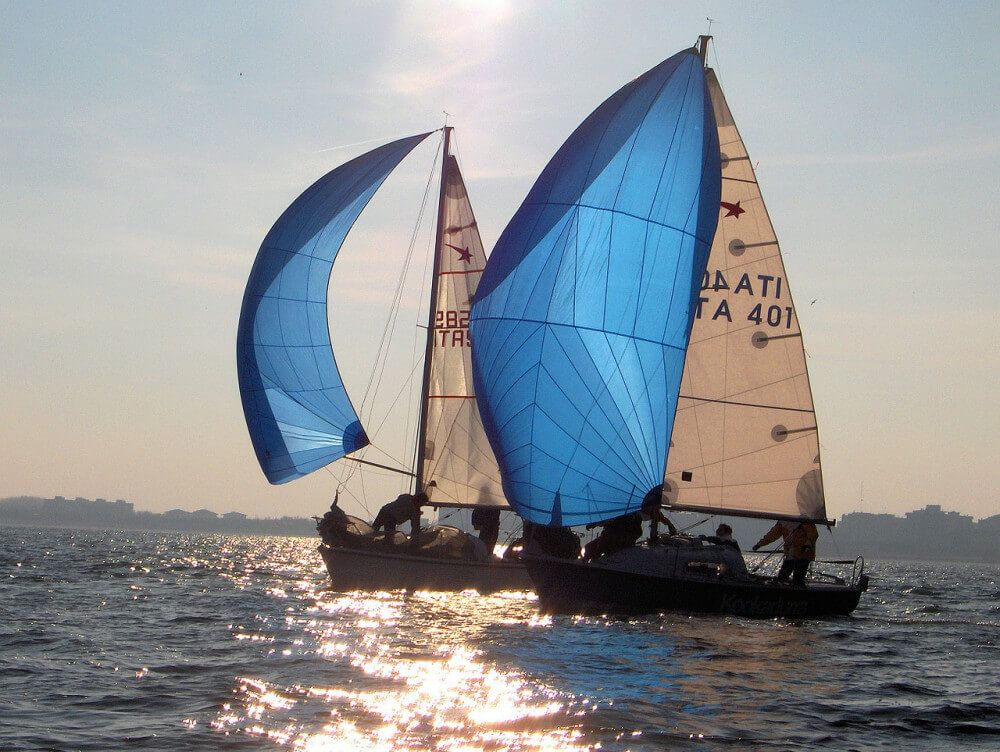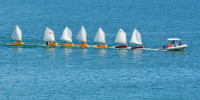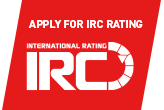RYA sail numbers

Sail numbers are an important way of uniquely identifying a yacht for a variety of purposes. They are a requirement for racing including dinghy, keelboat, windsurfing and yacht racing, and could be critical in a search and rescue situation. You can request a sail number to be issued to your boat online. Sail numbers are issued sequentially and payment can be made online.
Please note that this does not include the actual sail numbers to apply to the sails. These must be purchased from a chandlery or sail-maker, and their application should conform to the physical specifications advised to you with your allocation.
*Your level of discount will depend upon your membership type.
Non Member - RYA Sail Numbers £40.00 Personal/Accredited Members - RYA Sail Numbers £20.00 Gold Members - free RYA Sail Numbers
RYA members: to claim this benefit, log in to your MyRYA account to view all of your exclusive RYA member offers. Not a member? Register and join now to claim this benefit and for access to all the exclusive RYA member offers.

How Are Sail Numbers Assigned? (And how to pick yours)
When ordering a new sail, one is confronted with the bitter truth: 'I don't know where sail numbers come from'. But neither do I - about time we find out.
How are sail numbers assigned? Sail numbers are generally assigned in consecutive order. They are assigned by either the builder, class association (for inland competitive racing), or national authority (required for offshore racing yachts). It isn't mandatory to register an official number. If you don't compete you may assign your own number.
It's simple enough I guess. If you participate in competition you do have to get it right though. In this article I'll go over the different authorities, and where you can apply for your number. If you want 5 cool ideas for your own sail number, read on till the end. But first, let's get into the math.

On this page:
Who issues them, do i need one, how to get yours, some tips on applying your numbers, 5 cool ideas for sail numbers, related questions.
There are four types of sail numbers, and they all get issued by different parties:
- Factory numbers - issued by the builder
- Class numbers - issued by the class association
- International numbers - issued by the national authority
- Creative numbers - issued by you
But before you start peeling off those numbers and apply some obscure mathematical theoru, lets make sure you get it right.
Factory numbers
The boat builder can put whatever number they like best on the sails. They use there own numbering systems, which are generally related to the build or hull number. They can reserve code blocks with the national authorities for larger offshore sailing yachts that require international registration. This way they won't have to break their neat number streak.
Class numbers
Class associations can also issue sailing numbers. For example, the International Laser Class Association (ILCA) issues numbers for laser racing, the International Optimist Dinghy Association (IODA) issues them for Dinghy, Tasar for Tasar, and so on.
They issue numbers to participate in their own races and tournaments. These are not internationally recognized, and there may be duplicate numbers across classes and countries. They may look something like this:
189882 BEL or ... FJ NED 775
International sail numbers
If you participate in offshore racing, or if you own an offshore racing yacht, you require international sail numbers. These are issued by your national authority. It's the fancy number with the country code as prefix. They're generally formatted something like this:
AUS 6133 or ... GBR 4567T
Check out this great resource at Wikipedia for a complete list of country codes .
The national authorities are:
- Sailing Canada
- Australian Sailing
Creative numbers
As long as you don't sail offshore and don't happen to own a yacht that can sail in international waters, you don't actually need a sail number. Your boat probably already has a number. I bet it's a boring one. Most sailboats come with numbers applied by the builder. Good news: you may remove them. You're allowed to alter them or replace them with anything like. These tend to look as follows:
Tip: If you have a sail with a build number but are unsure if its the original one: some manufacturers scribe the build number under the drawers, seats, behind pillows and so on.
So it isn't mandatory to use sail numbers for anything on inland waters. In most countries you are required to have a hull number for identification. That's a bit like a car's registration plate. But no sail number. If you do want to have a number, it doesn't have to match your hull number.
But that changes when you enter into competition. It makes sense that the race organizers need a way to identify you. To keep it simple, let me split it up. There are only three possible scenarios:
- You don't race: you use the number issued by the builder, or make up your own
- You race on inland waters: you use the number issued by the class association
- You race offshore or own a very large yacht (good for you): you use the number issued by the national authority (RYA, USS, SC, AuS)
ISAF requires country codes for sailboats international waters. Offshore numbers are essential for all racing yachts, and also recommended by the RYA for cruisers on sea. They are very important for identifying you and help with assist an rescue situations.
The RYA actually recommends all yachts to have a unique sail number. They also issue numbers for dinghy and keelboat sail, and windsurfers as well. So if you want, you can get your official GBR code, but it will cost you, and my guess is you can come up with something way more original.
You can simply apply for a number online for a small fee - currently about 30 pounds. But this is only the registration. You have to get the actual numbers yourself from a sail-maker or chandlery (they're very cheap).
Registrating a sail number costs you anywhere between $50 - $200 . In the US, registration costs you $100 - 125. In Australia: $220 AUD. Canada charges $150 CAD. The UK is actually the least expensive, at £30.00.
Canada also offers cool premium 1-digit numbers, coming in at $5,000. Be quick, only 9 left! You can also get yourself an Out of Sequence number, which is similar to the US automotive license plates. Could be great fun.
RYA : If you're a gold member, you get your number for free. Gold membership costs ... oh wait, you can only become Gold member by being a regular member for 10 consecutive years.
RYA issued sail numbers stay with the boat, even when the owner changes
RYA uses the suffixes M for monohulls and N for single-designs boats. Other than that, it's completely random.
You can apply for your numbers here:
- US Sailing (link to application form )
- RYA - UK (link to application form )
- Sailing Canada (link to application form )
- Australian Sailing (link to application form )
If you're ready to order your numbers, here are some things to consider:
- using vinyl or a cutout by a sign maker isn't a great idea - these usually fall off within a week
- the numbers use a special adhesive which can withstand water
- they are quite inexpensive so no need to cheap out
- the best numbers are sewn on, but they are more expensive (as you'd expect)
- Dacron is also good
- if you're not sure yet what you want on your sail, just order a bunch of 8s - they're easy to cut into any letter you need
- number of boats you've owned
- the year Columbus discovered the Americas (1492)
- the golden ratio (16180)
- longitude and latitude of your favorite restaurant
- your debit card pin code (no one will ever guess the obvious)
What is the sail number font? It's generally some sort of monospace (or block font). However, each class and organization uses their own font. In the US, it's common to use multiple 8s, which are then cut to size, resulting in an extreme rectangular monospace typeface.
What material are sail numbers made of? The most used material for sail numbers and insignia is adhesive backed Dacron. Dacron is a woven polyester fabric that's incredibly strong. It's one of the favorite materials used for sails up to 40'. Thanks to the tight weave it's very durable and retains shape really well.
Karta Healy
Hello Shawn Can you please assist me where Google has failed me? I recycle sails and have come across the biggest spinnaker I have ever handled. It has these number UAE 52. How does one go about finding out what the vessel they came from? Must have been a big Dubai show boat! Thanks Karta
Leave a comment
You may also like, how much do new sails cost.
Sooner or later it needs to happen: you need to replace those precious sails. Everybody knows it's expensive, but how expensive exactly? Let's look at the data.

How Much Do Sailing Lessons Cost?

How Much Fuel Does a Sailboat Use?

How Far Can You Sail In One Day?
- MYA Districts
- MYA Ranking Lists

- Personal Sail Number
- Measurement & Certification
Sail Numbers
Identification marks on sails for IRSA (including the IOM) and MYA classes have sizes and positions defined in the class rules. Download the relevant documents below to get the right size and placement on your sails.
Note – The Identification Marks rules in Appendix E of the RRS are replaced by these documents.
Personal Sail Numbers
The MYA operates a scheme allowing MYA Members to select a Personal Sail Number (where available and ranging from 00 to 99) which can be used across all IRSA and MYA class boats they sail. This service is available for a nominal fee and is limited to 100 numbers per District to prevent duplication. It’s important to note that a Personal Sail Number does not grant any advantages to the member during event registration or when entering Ranking or National Championships. The standard procedure of first-come, first-served applies in those cases.
The fee for a personal sail number is £20 for 5 years. To ask which numbers are available in your district please contact the Personal Sail Number Registrar. Contact details are in the Members Area or our officer contact page here
Members with PSN moving to a new District
Should a holder of a PSN transfer membership to a club in another MYA District:
a. they may retain the same PSN if it is not currently taken in that District, after consultation with the Personal Sail number registrar. b. they shall be responsible for acquiring a new PSN in that District, or c. they shall be responsible for changing sail number(s) to the last two digits of the hull registration number(s).
Treatment of historic issue
A PSN was transferred from one district to a another resulting in a duplicate PSN. On expiry of the transferred PSN, the owner will follow the rules in a, b, c above.

Attachments
- previous post: Health and Safety Information
- next post: Change of Boat Ownership Form
Sail Numbers
Issuing sail numbers.
In accordance with Class Rule 2.6.3 , sail numbers for British Europes are issued by the RYA, the national governing body for sailing in the UK. For those purchasing new boats, or importing boats into the UK, you will need to contact the RYA Technical Department , who will allocate your boat a new sail number. These are issued in numerical order, and can be obtained for £30, or £15 for RYA members.
If you have purchased an older Europe and are unsure of the correct sail number, get in touch with the RYA Technical Departmen t who keep a database of existing sail numbers. They will ask you for your serial number, listed on the IYRU/ISAF/World Sailing plaque of your boat, and should be able to match the serial number with a pre-registered number. If your boat is not on their database, it will most likely have never been registered in the UK. In this case, the RYA will assign a new sail number.
Fitting Sail Numbers
All sail numbers shall be fitted in accordance with Racing Rules of Sailing Appendix G, avaliable on World Sailing's website.
National letters and sail numbers shall be in capital letters and arabic numerals, of the same colour, of a contrasting colour to the body of the sail, and of a sans-serif typeface. In addition, the letters and numbers identifying the boat shall be clearly legible when the sail is set.
All characters shall have a minimum height of 300mm.
The minimum space between characters and from the edge of the sail shall be 60mm.
Class insignia, national letters and sail numbers shall be placed on both sides and such that those on the starboard side are uppermost.
National letters shall be placed above the sail numbers on each side of the sail.
For advice on applying sail numbers, click here to see Rooster's helpful video.
Changing Sail Numbers
For those looking to purchase second hand sails, the time may come when you need to remove an old number in order to replace it with your own number. It is important however to ensure no sticky residue is left behind on the sail, as this will attract dirt.
Peel off the old numbers.
To remove the sticky residue, use a solvent adhesive remover. Apply solvent to a soft cloth and rub over the adhesive until the solution can soak in.
Leave the sail for a bit while the solvent soaks in.
Using an old credit card, scrape off the old sticky residue.
Repeat this process if any residue remains, until there is no longer any sticky residue.
- sail-numbers
Offshore sail numbers
These sail numbers are an important way of uniquely identifying a yacht for search and rescue purposes and are a requirement of the Racing Rules of Sailing, Rule 77 - Identification on Sails. The RYA recommend that all yachts have a unique sail number.
The RYA is responsible for issuing L,N ,M (multihull) & X series with L being the current in sequence series. We are also responsible for updating historic Y & T series .
Allocation of a single number is free of charge to RYA Gold Members, £20.00 RYA Personal Members, and £40.00 to non members and companies.
It is also possible to obtain an Out Of Sequence sail number. These are a great way of personalising your vessel with a meaningful number. These are subject to availability, for further details and prices please contact either [email protected] or call 02380 60 4200.
Applying for an in sequence number

Eastleigh and District Model Boat Club

Sail Numbers
Most sailors have the last two digits of their boat’s registration number displayed on their sails. If you wish, it is possible to purchase a specific number, a Personal Sail Number, from the MYA, so that the same number can be displayed on all your boats. However, if you only intend to race at Lakeside, it is possible to informally choose your own number, taking care not to clash with any number already in use in the Club. You can do this by checking the table below. It is also best to check with the Sail Commodore, before marking your sails or buying expensive sail numbers.
Implementing the Changes to Sail Identification - IRSA update 2020 - click here
Dragon Force 65 & Dragon Flite 95 Registration
Registration of DF65 & DF95 is done through the National Class Association website ( https://dfracinguk.com/ ). The sail number may be the last two or three digits of the registration number, or if the member has a MYA personal Sail Number, this may be used. When a boat is sold, the number should go with it, as with other classes of model yacht.
The Class Rules were updated in October 2017 to allow the use of A+ rigs, in addition to the existing A, B and C rigs. The A+ rig will be adopted in this club from March 2019.
Active Club Yachts & Numbers


- Privacy Policy
- Terms & Conditions
- +44 (0)1590 677030
RORC Rating Services
- Weighing & Measurement
Class Administration
- Safety & Stability
Sail Numbers
- MyIRC application portal
- Information for owners
- MyIRC & IRC Application FAQs
- GBR IRC Fees
- IRC weighing & measurement
- IRC Rule & Definitions
- Trial certificate policy
- GBR IRC Championships
- IRC Single Event Rating (SER)
- IRC Advocate Scheme
- How Do I Start Racing?
- IRC GBR Rule Authority Prescriptions
- Race Management
- IRC TCC listing
- Industry IRC services
- Sail lofts & sail measurers
- GBR IRC Committee
- IRCrating.org
- MyIRC.rorcrating.com
- IRCRecords™
RORC Rating Office » Services » Sail Numbers
Yachts racing under the Racing Rules of Sailing (ie. any boat racing under any of the rating rules we administer) must hold an approved sail number as prescribed by her national authority. This sail number shall be displayed in accordance with RRS 77, Identification on Sails.
In the UK, sail numbers are issued by the RYA or by the RORC Rating Office. Sail numbers issued by the RYA will have a L, N or X suffix (M for multihulls). Clyde Yacht Clubs’ Association numbers (C suffix) are also approved under RRS Appendix G .
RORC sail numbers issued since 1993 have an R suffix and are available in the range 1000 – 9999 (eg. GBR1234R). The whole number including the suffix letter must be displayed on the sails and declared for your IRC certificate.
To apply for a standard 4-figure RORC sail number please register with MyIRC if you have not already done so. You then have the option to select and pay for your sail number online, and will get a discount on the sail number fee.
If you experience problems with this please contact the Rating Office.
Current RORC Members may hold a 3-figure sail number, although there are very few of these still available. Please contact the Rating Office.
To apply for a number through the RYA , see https://www.rya.org.uk/racing/technical/sail-numbers The fee varies depending on your membership; out of sequence numbers can also be obtained – please email [email protected] to check availability and for more details.
Royal Ocean Racing Club Rating Office
IRC Rating Rule
Measurement
Search rorcrating.com

IMAGES
COMMENTS
The RYA recommend that all yachts have a unique sail number. If the owner sells the boat on, except in exceptional circumstances, the sail number remains with the boat and details of the new owner should be passed on to the RYA Technical Department with the appropriate registration fee. Sail Numbers will be in the form of: GBR four digit number ...
These sail numbers are an important way of uniquely identifying a yacht for search and rescue purposes and are a requirement of the Racing Rules of Sailing, Rule 77 - Identification on Sails. The RYA recommend that all yachts have a unique sail number. The RYA is responsible for issuing L,N,M ...
These must be purchased from a chandlery or sail-maker, and their application should conform to the physical specifications advised to you with your allocation. *Your level of discount will depend upon your membership type. Non Member - RYA Sail Numbers £40.00 Personal/Accredited Members - RYA Sail Numbers £20.00 Gold Members - free RYA Sail ...
US Sailing; RYA (UK) Sailing Canada; Australian Sailing; Creative numbers. As long as you don't sail offshore and don't happen to own a yacht that can sail in international waters, you don't actually need a sail number. Your boat probably already has a number. I bet it's a boring one. Most sailboats come with numbers applied by the builder.
The fee for a personal sail number is £20 for 5 years. To ask which numbers are available in your district please contact the Personal Sail Number Registrar. Contact details are in the Members Area or our officer contact page here. Members with PSN moving to a new District. Should a holder of a PSN transfer membership to a club in another MYA ...
In accordance with Class Rule 2.6.3, sail numbers for British Europes are issued by the RYA, the national governing body for sailing in the UK. For those purchasing new boats, or importing boats into the UK, you will need to contact the RYA Technical Department, who will allocate your boat a new sail number. These are issued in numerical order ...
The RYA Technical Department issues offshore sail numbers, essential for all racing yachts and advisory for cruising yachts venturing to sea These sail numbers are an important way of uniquely identifying a yacht for search and rescue purposes and are a requirement of the Racing Rules of Sailing, Rule 77 - Identification on Sails.
The sail number may be the last two or three digits of the registration number, or if the member has a MYA personal Sail Number, this may be used. When a boat is sold, the number should go with it, as with other classes of model yacht.
On cruising boats, the sail number is usually the hull number; but if the boat is going to be raced more than local club races, the boat will need to get a number from national sailing federations like US Sailing, Sail Canada, the Royal Yachting Association, etc. There is a charge per character for numbers and country codes.
This sail number shall be displayed in accordance with RRS 77, Identification on Sails. In the UK, sail numbers are issued by the RYA or by the RORC Rating Office. Sail numbers issued by the RYA will have a L, N or X suffix (M for multihulls). Clyde Yacht Clubs’ Association numbers (C suffix) are also approved under RRS Appendix G .